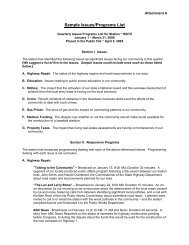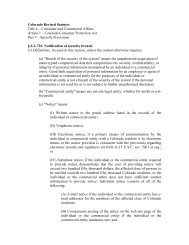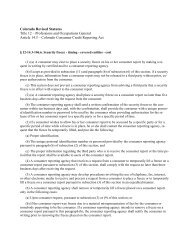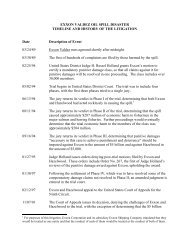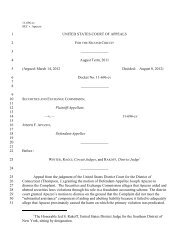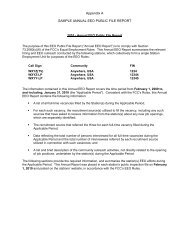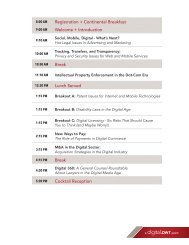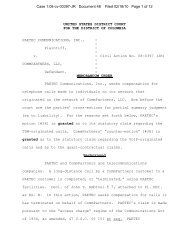QUANTA SERVICES INC, QUANTA SERVICES MANAGEMENT ...
QUANTA SERVICES INC, QUANTA SERVICES MANAGEMENT ...
QUANTA SERVICES INC, QUANTA SERVICES MANAGEMENT ...
You also want an ePaper? Increase the reach of your titles
YUMPU automatically turns print PDFs into web optimized ePapers that Google loves.
anticipate continuing development of renewable energy projects in the near-term, primarily utility-scale solar<br />
facilities, creating increased opportunities for our engineering, procurement and construction services for these<br />
projects.<br />
With respect to our electric power distribution services, we saw a slowdown in spending by our customers<br />
for more than two years on their distribution systems, which we believe is due primarily to adverse economic and<br />
market conditions. Some increase in distribution spending occurred in the latter part of 2010 and throughout<br />
2011, but we are cautious with respect to the sustainability of the increase in distribution spending given<br />
continued economic uncertainties. However, as a result of reduced spending by utilities on their distribution<br />
systems for the past few years, we believe there is a growing need for utilities to resume sustained investment on<br />
their distribution systems to properly maintain the system and to meet reliability requirements. We also anticipate<br />
that utilities will continue to integrate “smart grid” technologies into their transmission and distribution systems<br />
to improve grid management and create efficiencies. Development and installation of smart grid technologies and<br />
other energy efficiency initiatives have benefited from stimulus funding under the American Recovery and<br />
Reinvestment Act of 2009 (ARRA), as well as the implementation of grid management initiatives by utilities and<br />
the desire by consumers for more efficient energy use.<br />
Several existing, pending or proposed legislative or regulatory actions may also positively affect demand for<br />
the services provided by this segment in the long term, particularly in connection with electric power<br />
infrastructure and renewable energy spending. For example, legislative or regulatory action that alleviates some<br />
of the siting and right-of-way challenges that impact transmission projects would potentially accelerate future<br />
transmission line construction. The Federal Energy Regulatory Commission (FERC) recently issued FERC Order<br />
No. 1000 to promote more efficient and cost-effective development of new transmission facilities. The order<br />
establishes transmission planning and cost allocation requirements intended to facilitate multi-state electric<br />
transmission lines and to encourage competition by removing, under certain conditions, federal rights of first<br />
refusal from FERC-approved tariffs and agreements. We believe FERC Order No. 1000 will have a favorable<br />
impact on electric transmission line development, although the impact of its implementation is not expected to<br />
occur for several years. We also anticipate increased infrastructure spending by our customers as a result of<br />
legislation requiring the power industry to meet federal reliability standards for its transmission and distribution<br />
systems and providing incentives to the industry to invest in and improve maintenance on its systems. Certain<br />
aspects of the ARRA have also provided various incentives, such as tax credits, grants and loan guarantees, for<br />
renewable energy, energy efficiency and electric power infrastructure projects, although the feasibility of similar<br />
projects in the future will be affected when or if these incentives are no longer in effect. The benefits of pending<br />
or proposed legislation could also be impacted by the timing and scope of such legislation if and when enacted.<br />
Several industry and market trends are also prompting customers in the electric power industry to seek<br />
outsourcing partners. These trends include an aging utility workforce, increasing costs and labor issues. We<br />
believe the economic recession in the United States slowed employee retirements by many utility workers,<br />
causing the growth trend in outsourcing to temporarily pause. As the economy continues to recover, we believe<br />
utility employee retirements could return to normal levels, which should result in an increase in outsourcing<br />
opportunities. The need to ensure available labor resources for larger projects also drives strategic relationships<br />
with customers.<br />
Natural Gas and Pipeline Infrastructure Services Segment<br />
We see strong potential growth opportunities over the long-term in our natural gas and pipeline operations,<br />
primarily in the installation and maintenance of natural gas and oil pipelines, gathering systems and related<br />
facilities, as well as pipeline integrity and specialty services such as horizontal directional drilling. We believe<br />
opportunities for this segment exist as a result of the increase in the ongoing development of unconventional<br />
shale formations that produce natural gas and/or oil, as well as the development of Canadian oil sands, which will<br />
require the construction of transmission pipeline infrastructure to connect production with demand centers and<br />
the development of midstream gathering infrastructure within areas of production. We also believe the goals of<br />
64




